8.5 Senses
Senses[1]
As mentioned previously, a major role of sensory receptors is to receive information about the external environment around us or the state of our internal environment. Stimuli from multiple sources are received and relayed to the central nervous system, where it is integrated with other sensory information and sometimes higher cognitive functions to become a conscious perception of that stimulus. This central integration may then lead to a motor response.
Describing sensory function uses two different terms – sensation and perception. Sensation refers to receiving information from the environment that activates sensory receptor cells. Perception refers to the central processing of sensory stimuli into a meaningful pattern. Perception is dependent on sensation, but not all sensations are perceived.
Sensory Receptors
Sensory Receptor Classification by Cell Type
There are many different cells that interpret information about the environment. A neuron that has a free nerve ending has dendrites embedded in tissue that receive a sensation. Pain receptors called nociceptors and temperature receptors called thermoreceptors in the dermis of the skin are examples of neurons that have free nerve endings.
A neuron that has an encapsulated ending has sensory nerve endings that are encapsulated in connective tissue to enhance their sensitivity. An example of a neuron with an encapsulated ending is the Pacinian corpuscle (also known as lamellated corpuscle) that responds to pressure and touch in the dermis of the skin.
Specialized receptor cells have distinct structural components that interpret a specific type of stimulus. Photoreceptors, the cells in the retina that respond to light stimuli, are an example of a specialized receptor. See Figure 8.34[2] for an illustration of cells with free nerve endings, an encapsulated ending, and a specialized receptor cell.
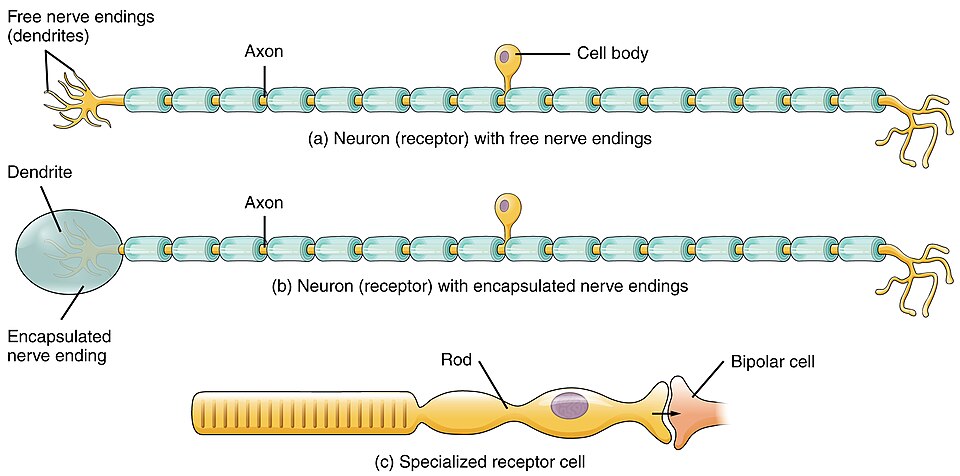
Sensory Receptor Classification by Location
Another way that receptors can be classified is based on their location relative to the stimuli. An exteroceptor is a receptor that is located near a stimulus in the external environment, such as the somatosensory receptors that are located in the skin. An interoceptor is one that interprets stimuli from internal organs and tissues, such as the baroreceptors that sense the increase in blood pressure in the aorta or carotid sinus. Finally, a proprioceptor is a receptor located near a moving part of the body, such as a muscle, that interprets position and movement.
Sensory Receptor Classification by Function
Sensory receptors called osmoreceptors, nociceptors, mechanoreceptors, and thermoreceptors are classified by their function. Table 8.5a provides an overview of the actions of sensory receptors.
Table 8.5a. Actions of Sensory Receptors
| Type of Receptor | Action |
|---|---|
| Osmoreceptor | Sense solute concentrations of body fluids. For example, osmoreceptors help maintain the osmolality of blood. |
| Nociceptor | Sense presence of chemicals from tissue damage, or similar intense stimuli. For example, pain is sensed by nociceptors. |
| Mechanoreceptor | Sense physical stimuli, such as pressure and vibration, as well as the sensation of sound and body position (balance). For example, mechanoreceptors sense a buzzing insect on your skin. |
| Thermoreceptor | Senses temperatures above (hot) or below (cold) normal body temperature. For example, a thermoreceptor senses a cold environment and stimulates shivering. |
General and Special Senses
Senses can be classified as either general or specific. A general sense is one that is distributed throughout the body, such as touch or pain. A special sense is any sensory system that is localized to a specific organ structure, namely the senses of smell, taste, sight, hearing, and balance.
General Senses
General senses are touch, proprioception (body movement), kinesthesia (body movement), or visceral sense (organ information), which is important to autonomic functions. The general sense of touch, which is known as somatosensation, can be separated into light pressure, deep pressure, vibration, itch, pain, temperature, or hair movement.
Somatosensation (Touch)
Somatosensation (touch) is considered a general sense, as opposed to the special senses discussed below. This means that its receptors are not associated with a specialized organ but are instead spread throughout the body in a variety of organs. Many of the somatosensory receptors are located in the skin, but receptors are also found in muscles, tendons, joint capsules, ligaments, and in the walls of visceral organs.
Two types of somatosensory signals that are transmitted by free nerve endings are pain and temperature. Temperature receptors (thermoreceptors) are stimulated when local temperatures differ from body temperature. Some thermoreceptors are sensitive to just cold and others to just heat. Nociceptors detect potentially damaging stimuli. Mechanical, chemical, or thermal stimuli beyond a set threshold will elicit painful sensations. Stressed or damaged tissues release chemicals that activate the nociceptors.
If you drag your finger across a textured surface, the skin of your finger will vibrate. Such low frequency vibrations are sensed by mechanoreceptors called Merkel cells, also known as Type I cutaneous mechanoreceptors. Merkel cells are located in the stratum basale of the epidermis. Deep pressure and vibration are sensed by Pacinian (lamellated) corpuscles, which are receptors with encapsulated endings found deep in the dermis and subcutaneous tissue. Light touch is sensed by the encapsulated endings known as Meissner (tactile) corpuscles. Follicles are also wrapped in a plexus of nerve endings known as the hair follicle plexus. These nerve endings detect the movement of hair at the surface of the skin, such as when an insect may be walking along the skin. Stretching of the skin is sensed by stretch receptors known as bulbous corpuscles. Bulbous corpuscles are also known as Ruffini corpuscles, or Type II cutaneous mechanoreceptors. Other somatosensory receptors are found in the joints and muscles. Stretch receptors monitor the stretching of tendons, muscles, and the components of joints. See Table 8.5b for a list of all the somatosensory receptors, where they are located, and the stimuli they detect.
Table 8.5b. Mechanoreceptors of Somatosensation[3]
| Name | Historical (eponymous) Name | Location(s) | Stimuli |
|---|---|---|---|
| Free nerve endings | None | Dermis, cornea, tongue, joint capsules, and visceral organs | Pain, temperature, mechanical deformation |
| Tactile discs | Merkel’s discs | Epidermal–dermal junction and mucosal membranes | Low frequency vibration (5–15 Hz) |
| Bulbous corpuscle | Ruffini’s corpuscle | Dermis and joint capsules | Stretch |
| Tactile corpuscle | Meissner’s corpuscle | Papillary dermis, especially in the fingertips and lips | Light touch and vibrations below 50 Hz |
| Lamellated corpuscle | Pacinian corpuscle | Deep dermis and subcutaneous tissue | Deep pressure and high-frequency vibration (around 250 Hz) |
| Hair follicle plexus | None | Wrapped around hair follicles in the dermis | Movement of hair |
| Muscle spindle | None | In line with skeletal muscle fibers | Muscle contraction and stretch |
| Tendon stretch organ | Golgi tendon organ | In line with tendons | Stretch of tendons |
Special Senses
A special sense is one that has a specific organ devoted to it, namely the eye, ear, tongue, or nose. The special senses include smell, taste, audition (hearing), balance, and vision.
Olfaction (Smell)
The sense of smell, or olfaction, is responsive to chemical stimuli. Humans can detect more than one trillion different scents![4] The olfactory receptors are located in the superior nasal cavity. As airborne molecules are inhaled through the nose, they dissolve into the mucus and are transported to the olfactory dendrites where they stimulate the olfactory neurons. The impulse is carried to the olfactory bulb on the frontal lobe. From there, the axons split to travel to several brain regions. Some travel to the cerebrum, specifically to the primary olfactory cortex that is located in the temporal lobe. Others project to structures within the limbic system and hypothalamus, where smells become associated with long-term memories and emotional responses. Smell is the one sense that does not synapse in the thalamus before traveling to the cerebral cortex. This intimate connection between the olfactory system and the cerebral cortex is another reason why smell can be a potent trigger of memories and emotion. See Figure 8.35[5] for an illustration of the olfactory system.
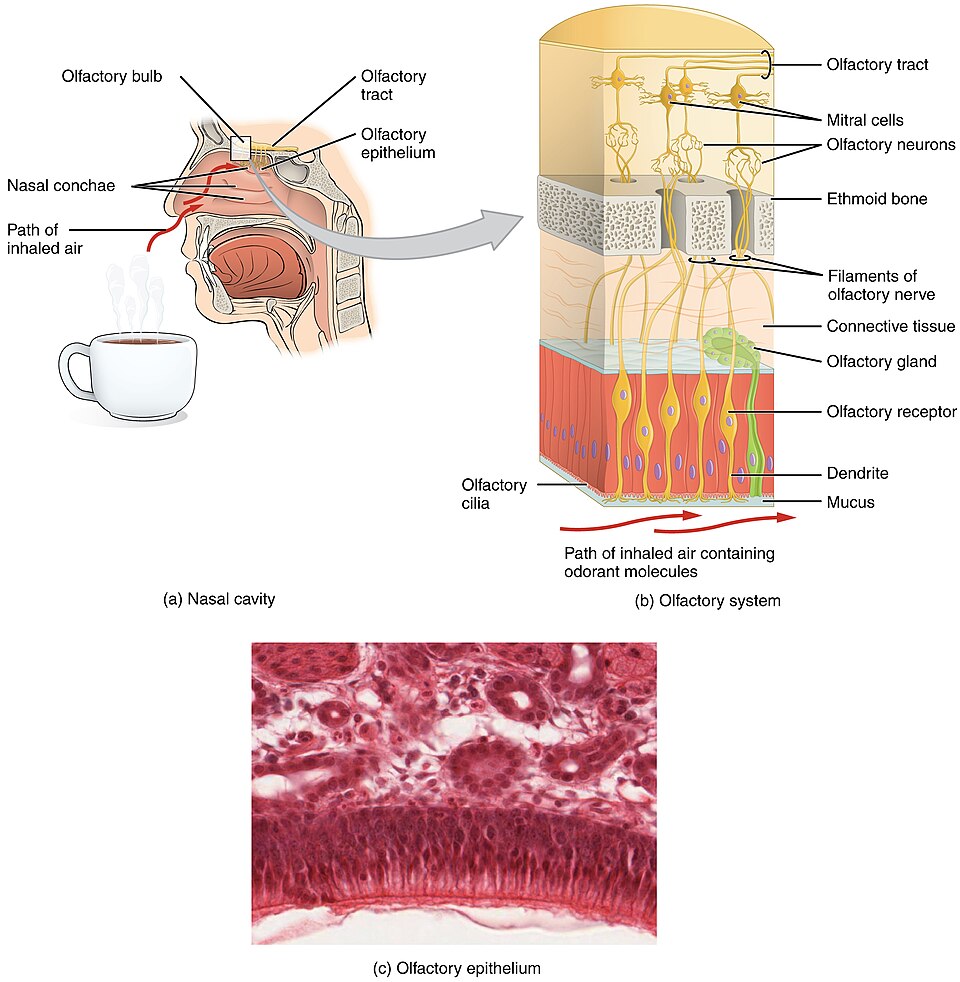
Gustation (Taste)
The sense of taste is also known as gustation. Until recently, only four tastes were recognized: sweet, salty, sour, and bitter. Recent research led to recognition of the fifth taste called umami. Umami is a Japanese word that means “delicious taste” and is often translated to mean savory. Additional research suggests there may also be a sixth taste for fats (lipids). Much of what you think is taste when you’re eating is actually really smell.
The receptors associated with gustation are located on the tongue. The surface of the tongue, along with the rest of the oral cavity, is lined by a stratified squamous epithelium. Raised bumps called papillae (singular = papilla) contain taste buds, the structures for taste. There are four types of papillae based on their appearance: circumvallate, foliate, filiform, and fungiform. See Figure 8.36[6] for an illustration of the different types of papillae. Within the structure of the papillae are taste buds that contain specialized gustatory receptor cells for taste. These receptor cells are sensitive to the chemicals contained in foods, and they release neurotransmitters based on the amount of the chemical in the food. Neurotransmitters from the gustatory cells can activate sensory neurons in the facial, glossopharyngeal, and vagus cranial nerves.
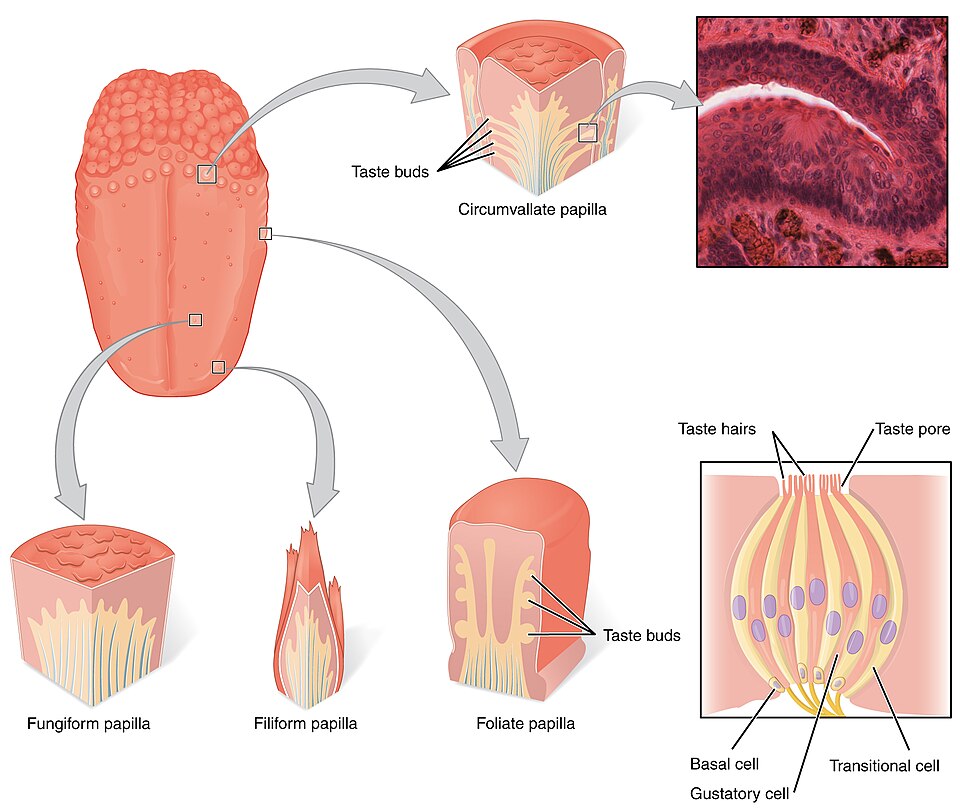
Audition (Hearing)
Audition is the sense of hearing, which is made possible by the structures and functions of several regions in the ear.
External (Outer) Ear
The auricle, external auditory canal, and tympanic membrane are often referred to as the external (or outer) ear. The earlobe, a large, fleshy structure on the lateral side of the head, is known as the auricle or pinna. The C-shaped curves of the auricle direct sound waves toward the external auditory canal. The external auditory canal enters the skull through the external auditory meatus of the temporal bone. At the end of the external auditory canal is the tympanic membrane, or eardrum, which vibrates when sound waves hit it.
Middle Ear
The middle ear consists of a space within the head that contains three small bones called the auditory ossicles. The three ossicles are the malleus, incus, and stapes, which are Latin names that roughly translate to hammer, anvil, and stirrup. The malleus is attached to the tympanic membrane and articulates with the incus. The incus, in turn, articulates with the stapes. The middle ear is connected to the pharynx through the eustachian tube, which helps equalize air pressure across the tympanic membrane. The tube is normally closed but will “pop” open when the muscles of the pharynx contract during swallowing or yawning. See Figure 8.37[7] for an illustration of the structures of the external, middle, and inner ear.
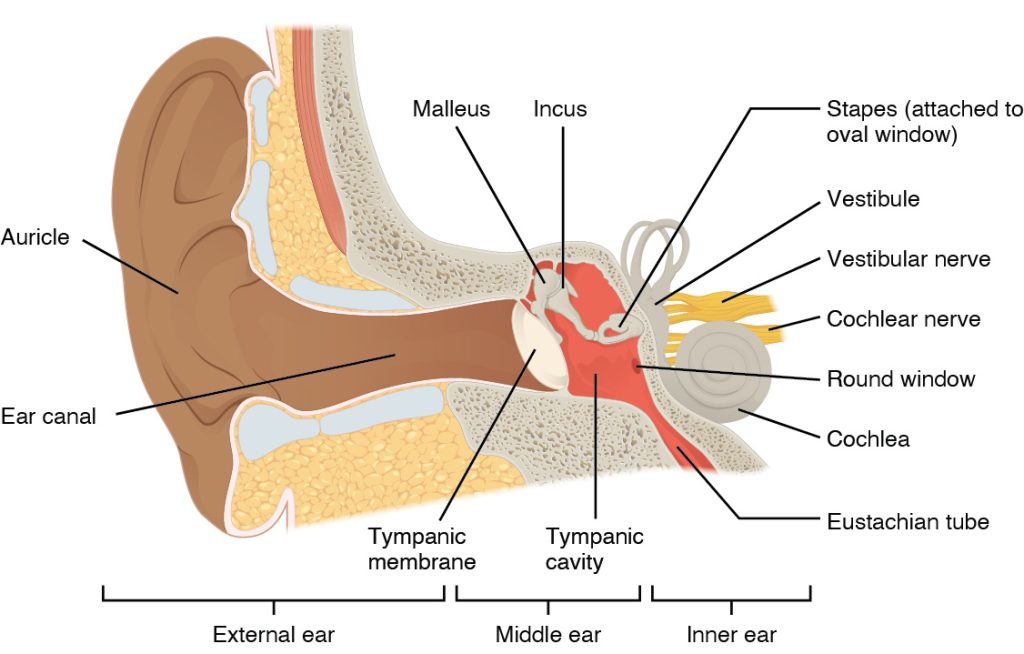
Inner Ear
The inner ear is often described as a bony labyrinth, as it is composed of a series of canals found within the temporal bone. It has two separate regions: the vestibule, along with its semicircular canals, which is responsible for balance, and the cochlea, which is responsible for hearing.
The semicircular canals are three ring-like extensions of the vestibule. One is oriented in the horizontal plane, whereas the other two are oriented in the vertical plane. The base of each semicircular canal, where it meets with the vestibule, connects to an enlarged region known as the ampulla. The ampulla contains the hair cells that respond to rotational movement, such as turning the head while saying “No.”
The spiral-shaped cochlea is the auditory portion of the inner ear containing structures to transmit sound stimuli. The cochlear duct is a space within the auditory portion of the inner ear and contains several organs of Corti, structures that change sound waves into neural signals.
The neural signals from the vestibule and the cochlea travel to the brain stem through separate fiber bundles. However, these two distinct bundles travel together from the inner ear to the brain stem as the vestibulocochlear nerve (Cranial Nerve VIII). See Figure 8.38[8] for an illustration of the cochlea and Figure 8.39[9] for an illustration of sound waves to the cochlea.
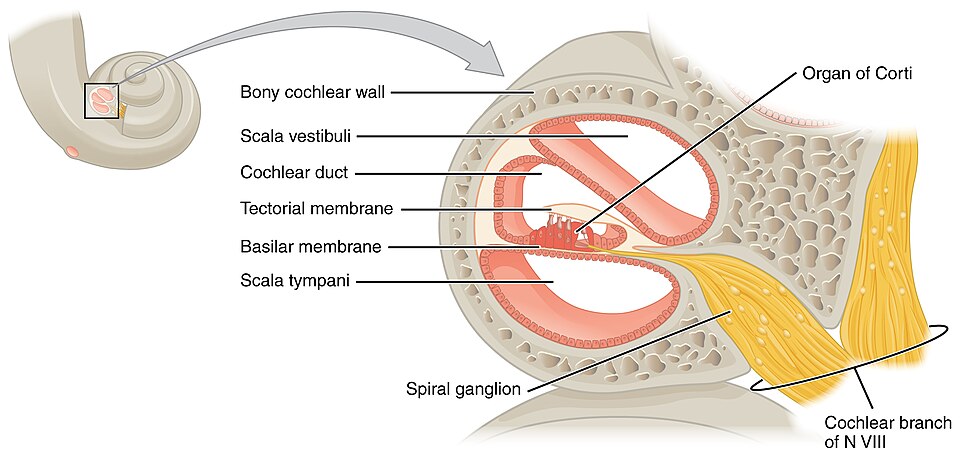
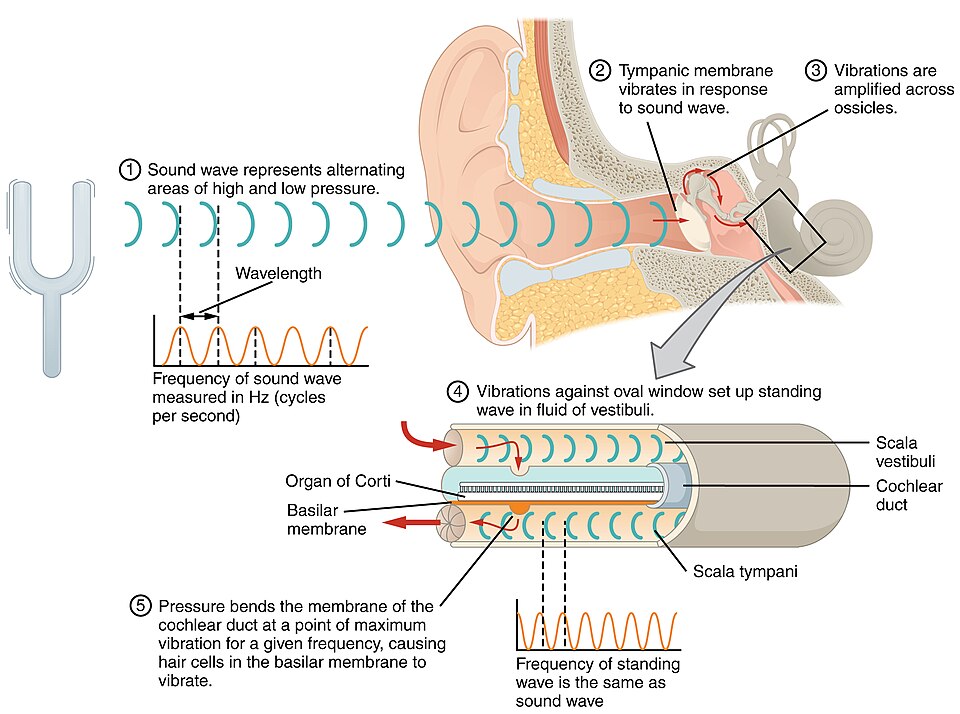
Inside each cochlea is a structure called the organ of Corti (or spiral organ). This structure contains mechanoreceptor cells called hair cells, which convert sound vibrations into nerve impulses. The hair cells found along the length of the cochlear duct are each sensitive to a particular frequency, allowing the cochlea to separate auditory stimuli by frequency, just as a prism separates visible light into its component colors. Our ability to detect differences in pitch, loudness, and localization of sound can be attributed to the deflections in our hair cells. The cochlea encodes auditory stimuli for frequencies between 20 and 20,000 Hz, which is the range of sound that human ears can detect. These delicate hair cells aren’t replaced if they’re damaged or lost as we age. See Figure 8.40[10] for an illustration of a hair cell.
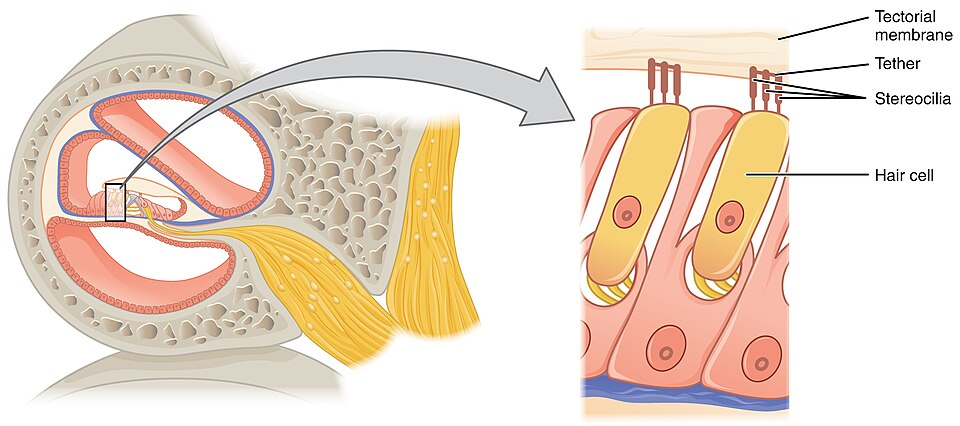
Equilibrium (Balance)
Along with hearing, the inner ear is responsible for equilibrium, the sense of balance. A similar mechanoreceptor—hair cells —senses head position, head movement, and whether our bodies are in motion. These cells are located within the vestibule of the inner ear. Head position is sensed by specialized structures called the utricle and saccule. Movement is sensed by the semicircular canals, three ring-like extensions adjacent to the vestibule. One is oriented in the horizontal plane, whereas the other two are oriented in the vertical plane. See Figure 8.41[11] for an illustration of the internal ear and the semicircular canals.
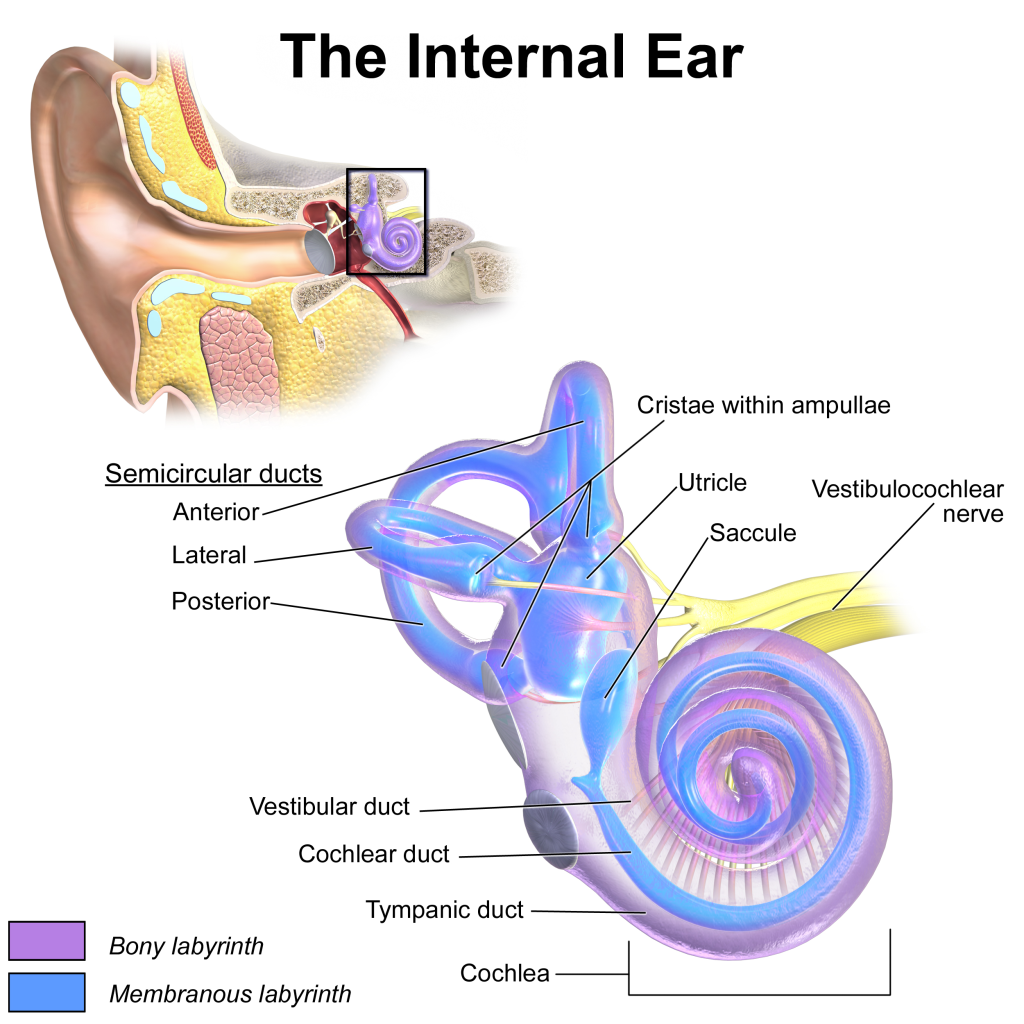
Vision
Vision is the special sense of sight that is based on light stimuli entering through the eyes. The eyes are located within the bony orbits in the skull, which protect and anchor the soft tissues of the eye. See Figure 8.42[12] for an illustration of the eye orbit. The eyelids, with lashes at their leading edges, help to protect the eye from abrasions by blocking dirt and debris that may land on the surface of the eye. The inner surface of each lid is lined with a thin membrane known as the palpebral conjunctiva. The conjunctiva extends over the white areas of the eye (the sclera), connecting the eyelids to the eyeball. Tears are produced by the lacrimal gland, located just inside the orbit, superior and lateral to the eyeball. Tears produced by this gland flow over the conjunctiva and exposed surface of the eyeball, washing away foreign particles. The tears then flow into the lacrimal duct in the medial corner of the orbit that drains tears into the nasal cavity.
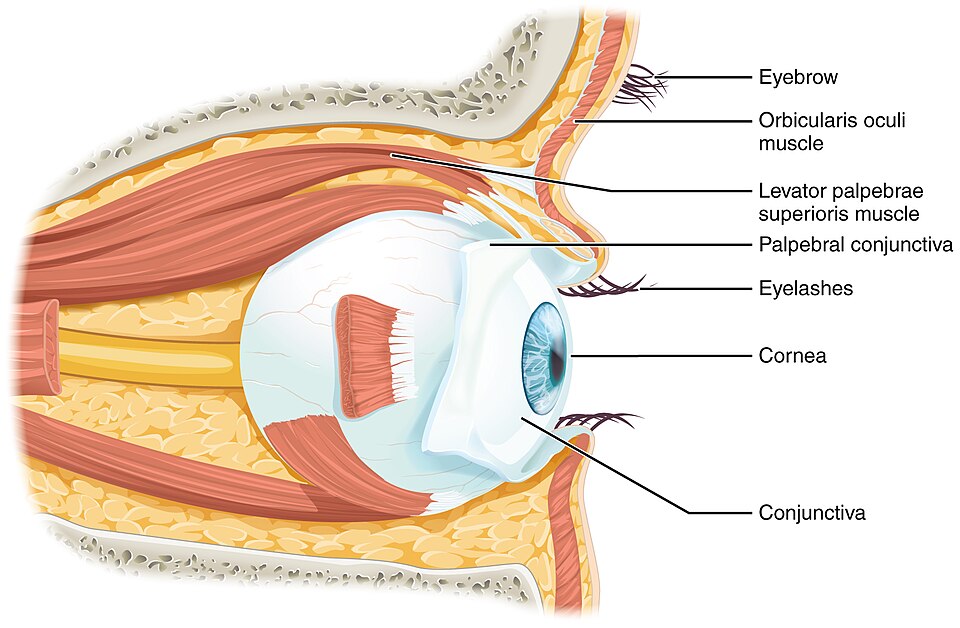
Movement of the Eye
Movement of the eye within the orbit is accomplished by the contraction of six extraocular muscles that originate from the bones of the orbit and insert into the surface of the eyeball. Four of the muscles arranged around the eye are named for their locations. They are the superior rectus, medial rectus, inferior rectus, and lateral rectus. The other two are the inferior oblique and superior oblique. See Figure 8.43[13] for an illustration of the extraocular muscles. When each of these muscles contracts, the eye moves toward the contracting muscle. For example, when the superior rectus contracts, the eye rotates to look up. The extraocular muscles are innervated by three cranial nerves – the abducens, oculomotor, and trochlear nerves. These cranial nerves connect to the brain stem, which coordinates eye movements.
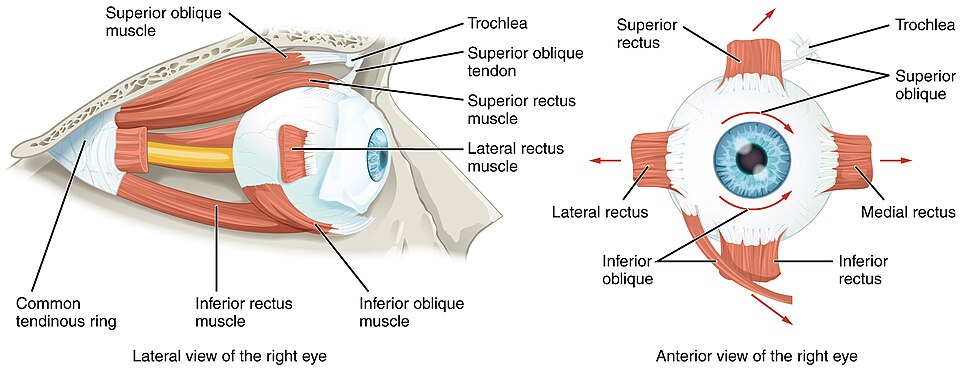
Tunics (Layers) of the Eye
The eye itself is a hollow sphere composed of three layers of tissue. The outermost layer is the fibrous tunic, which includes the white sclera and clear cornea. The transparent cornea covers the anterior part of the eye. It allows light to enter, and along with the lens, focuses light onto the retina. The sclera is a tough protective structure. The middle layer of the eye is the vascular tunic (or uvea), which is mostly composed of the choroid, ciliary body, and iris. The choroid is a layer of highly vascularized connective tissue that provides a blood supply to the eyeball. The choroid is posterior to the ciliary body, a muscular structure that is attached to the lens by suspensory ligaments, or zonule fibers. These two structures bend the lens, allowing it to focus light on the back of the eye. Overlaying the ciliary body and visible in the anterior eye, is the iris—the colored part of the eye. The iris is a smooth muscle that dilates or constricts the pupil, which is the black hole in the center of the iris that allows light to enter the eye. The iris constricts the pupil in response to bright light and dilates the pupil in response to dim light. The innermost layer of the eye is the retina or neural tunic, which contains the rods and cones responsible for photoreception.
The eyeball is divided into two cavities: the anterior cavity and the posterior cavity. The anterior cavity is the space between the cornea and lens, including the iris and ciliary body. It is filled with a thin, watery fluid called the aqueous humor that is constantly being refreshed. The posterior cavity is the space behind the lens that extends to the posterior side of the interior eyeball, where the retina is located. The posterior cavity is filled with a more viscous or jelly-like fluid called the vitreous humor. The vitreous humor is produced during fetal eye development and is never replaced or refreshed.
The retina is composed of photoreceptors called rods and cones that generate a nerve impulse when stimulated by light energy. These nerve impulses are sent to the brain through the optic nerve. The area of the retina where the optic nerve leaves the eye is called the optic disc or “blind spot.” Because the optic nerve passes through the retina, there are no photoreceptors at the very back of the eye, where the optic nerve begins. This creates a blind spot in the retina and a corresponding blind spot in our visual field. See Figure 8.44[14] for an illustration of the structures of the eye.
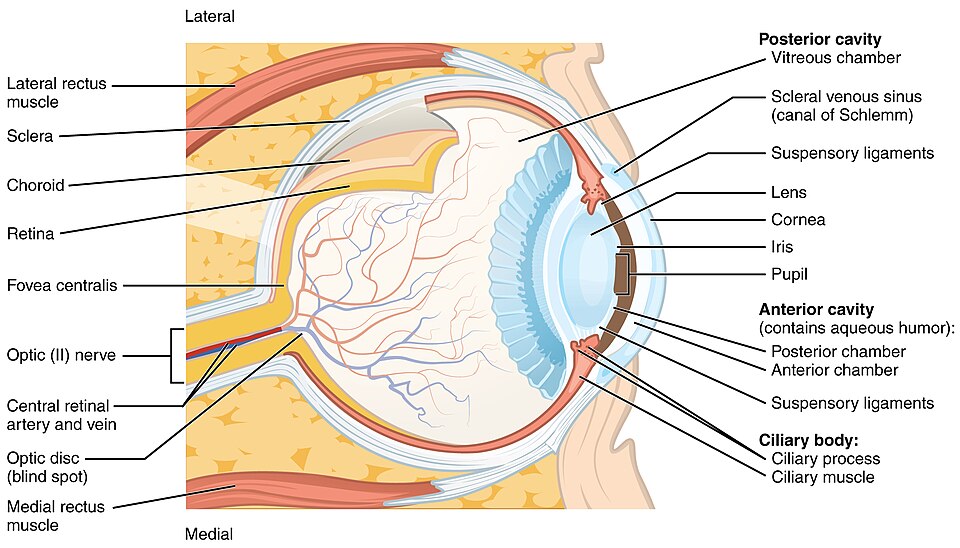
Photoreceptors (rods and cones) in the retina are located behind axons, cells, and retinal blood vessels. A significant amount of light is absorbed by these structures before the light reaches the photoreceptor cells. Located in the exact center of the retina is the macula lutea, an area containing a large number of cones providing increased visual clarity. In this macula lutea is a small area known as the fovea (fovea centralis). At the fovea, the retina only contains cones, and there are no blood vessels. Therefore, visual acuity, or the sharpness of vision, is greatest at the fovea. The difference in visual acuity between the fovea and peripheral retina is easily evidenced by looking directly at a word in the middle of this paragraph. The visual stimulus in the middle of the field of view falls on the fovea and is in the sharpest focus. Without moving your eyes off that word, notice that words at the beginning or end of the paragraph are not in focus. The images in your peripheral vision are focused by the peripheral retina and have vague, blurry edges and words that are not as clearly identified. As a result, a large part of the neural function of the eyes is concerned with moving the eyes and head so that important visual stimuli are centered on the fovea.
As previously mentioned, there are two types of photoreceptors—rods and cones. Rods detect shades of black and grey and do not function in bright light. Therefore, our low-light vision is grayscale. In a dark room, everything appears as a shade of gray. If you think that you can see colors in the dark, it is most likely because your brain knows what color something is and is relying on that memory.
Cones detect color and do function in bright light. In a darkened room, there is not enough light to activate cones, and vision is entirely dependent on rods. The pigments in human eyes are specialized in perceiving three different primary colors: red, green, and blue.
Complete this supplementary learning activity from Wisc-Online: The Sense of Sight.
- Betts, J. G., Young, K. A., Wise, J. A., Johnson, E., Poe, B., Kruse, D. H., Korol, O., Johnson, J. E., Womble, M., & DeSaix, P. (2022). Anatomy and physiology 2e. OpenStax. https://openstax.org/books/anatomy-and-physiology-2e/pages/1-introduction ↵
- “1401_Receptor_Types” by OpenStax is licensed under CC BY 4.0 ↵
- Betts, J. G., Young, K. A., Wise, J. A., Johnson, E., Poe, B., Kruse, D. H., Korol, O., Johnson, J. E., Womble, M., & DeSaix, P. (2022). Anatomy and physiology 2e. OpenStax. https://openstax.org/books/anatomy-and-physiology-2e/pages/1-introduction ↵
- Bushdid, C., Magnasco, M. O., Vosshall, L. B., & Keller, A. (2014). Humans can discriminate more than 1 trillion olfactory stimuli. Science, 343(6177). https://www.nih.gov/news-events/nih-research-matters/humans-can-identify-more-1-trillion-smells#:~:text=March%2031%2C%202014-,Humans%20Can%20Identify%20More%20Than%201%20Trillion%20Smells,more%20discriminating%20than%20previously%20thought ↵
- “1403_Olfaction” by OpenStax is licensed under CC BY 4.0 ↵
- “1402_The_Tongue” by OpenStax is licensed under CC BY 4.0 ↵
- “dd97d7920818a0a5b338a427a1d846043b156238” by Rice University, OpenStax is licensed under CC BY 4.0. Access for free at https://openstax.org/books/anatomy-and-physiology-2e/pages/14-1-sensory-perception ↵
- “1406_Cochlea” by OpenStax is licensed under CC BY 4.0 ↵
- “1405_Sound_Waves_and_the_Ear” by OpenStax is licensed under CC BY 4.0 ↵
- “1407_The_Hair_Cell” by OpenStax is licensed under CC BY 4.0 ↵
- “Blausen_0329_EarAnatomy_InternalEar” by Blausen.com staff (2014). “Medical gallery of Blausen Medical 2014” is licensed under CC BY 3.0 ↵
- “1411_Eye_in_The_Orbit” by OpenStax College is licensed under CC BY 3.0 ↵
- “1412_Extraocular_Muscles” by OpenStax College is licensed under CC BY 3.0 ↵
- “1413_Structure_of_the_Eye” by OpenStax College is licensed under CC BY 3.0 ↵
Receiving information about the environment to take in what is happening outside and within the body.
The central processing of sensory stimuli into a meaningful pattern.
A neuron that has dendrites embedded in tissue that receive a sensation.
Pain receptors in the skin.
Sensory receptors that detect temperature changes.
Refers to a type of neuron that has sensory nerve endings surrounded in connective tissue to enhance their sensitivity.
Cells in the retina that respond to light stimuli.
A receptor that is located near a stimulus in the external environment.
A receptor that interprets stimuli from internal organs and tissues.
Type of interoceptors that sense the increase in blood pressure in the aorta or carotid sinus.
A receptor located near a moving part of the body, such as a muscle, that interprets position and movement.
Sense solute concentrations of body fluids.
A type of neuron that perceives pain.
Sense physical stimuli, such as pressure and vibration, as well as the sensation of sound and body position (balance).
Senses temperatures above (hot) or below (cold) normal body temperature.
Sense that is distributed throughout the body, such as touch or pain.
Any sensory system that is localized to a specific organ structure, namely the senses of smell, taste, sight, hearing, and balance.
The body's ability to sense its position, movement, and force without visual input.
A general sense referring to body movement.
The perception of internal bodily sensations—such as hunger, fullness, nausea, or the need to urinate—arising from internal organs.
The general sense of touch, which can be separated into light pressure, deep pressure, vibration, itch, pain, temperature, or hair movement.
Sense of smell
A neural structure located in the forebrain that processes smell information received from the nasal cavity.
Sense of taste
Japanese word that means “delicious taste” and is often translated to mean savory.
Small, raised structures on the tongue's surface that enhance grip and contain taste buds.
Specialized sensory organs located on the tongue and other parts of the mouth that detect the five basic tastes: sweet, salty, sour, bitter, and umami.
Cells found in taste buds that are responsible for taste.
The sense of hearing.
Consists of the auricle, external auditory canal, and tympanic membrane.
A large, fleshy structure on the lateral side of the head; also called the pinna or earlobe.
The visible, external part of the ear, also known as the auricle.
The location where the external auditory canal enters the skull.
Eardrum.
Part of the ear separated from the outer ear by the tympanic membrane and transmits sound waves from the tympanic membrane to the partition between the middle and inner ears through a chain of tiny bones.
The three smallest bones in the human body—malleus (hammer), incus (anvil), and stapes (stirrup)—located in the middle ear.
Latin term for a small bone in the middle ear; also called the hammer.
Latin term for a small bone in the middle ear; also called the anvil.
The smallest bone in the human body, shaped like a stirrup, located in the middle ear.
Connects the middle ear to the pharynx and helps equalize air pressure across the tympanic membrane.
Chamber of the inner ear responsible for balance and spatial orientation.
The auditory portion of the inner ear containing structures to transmit sound stimuli.
Three loop-shaped structures in the inner ear that detect rotational movements of the head. They help maintain balance by sending signals to the brain about head orientation.
A space within the auditory portion of the inner ear.
Structures that change sound waves into neural signals.
Mechanoreceptors cells found in the ear that convert sound vibrations into nerve impulses.
The sense of balance.
A small, sac-like structure in the inner ear's vestibule that detects horizontal head movements and linear acceleration.
A small, sac-like structure in the inner ear's vestibule that detects vertical head movements and gravity.
Special sense of sight that is based on light stimuli entering through the eyes.
A thin membrane that lines the inner surface of the eyelids and extends over the white part of the eye, connecting the eyelids to the eyeball.
Gland that produces tears in the eye.
A small channel that carries tears from the eye into the nose. It helps drain excess tears, which is why your nose may run when you cry.
Six small muscles around each eye that control its movement in different directions. They allow us to look up, down, left, right, and rotate our eyes.
Moves the eye upward (elevation), inward (adduction), and rotates it inward (intorsion).
An extraocular eye muscle that coordinates eye movements.
An extraocular eye muscle that moves the eye downward (depression), inward (adduction), and rotates it outward (extorsion).
An extraocular eye muscle that coordinates eye movements.
An extraocular muscle that moves the eye upward (elevation), outward (abduction), and rotates it outward (extorsion).
An eye muscle that moves the eye downward and outward and rotates it inward.
The outermost layer of tissue of the eye.
The tough, white outer layer of the eye that maintains its shape, protects internal structures, and provides attachment points for eye muscles.
Covers the anterior part of the eye. It allows light to enter, and along with the lens, focuses light onto the retina.
A part of the eye that focuses light rays.
The middle layer of the eye, located between the outer fibrous layer (sclera and cornea) and the inner retina.
Layer of highly vascularized connective tissue that provides a blood supply to the eyeball.
A muscular structure that is attached to the lens of the eye by suspensory ligaments, or zonule fibers.
A network of fine, elastic fibers that connect the ciliary body to the lens of the eye.
The colored part of the eye.
Black hole in the center of the iris that allows light to enter the eye.
The light-sensitive layer at the back of the eye that captures visual information and sends it to the brain via the optic nerve.
Another name for the eye’s retina; it contains the rods and cones responsible for photoreception.
Thin, watery fluid found between the cornea and lens of the eye.
Viscous or jelly-like fluid.
Nerve responsible for transmitting visual information from the retina to the brain.
An area at the back of the eye in the retina where there are no photoreceptors; commonly called a “blind spot.”
A small area in the macula lutea of the eye; visual acuity is greatest at this point.
The sharpness or clarity of vision, typically measured at a distance of 20 feet using a standardized eye chart.
Detect shades of black and grey and do not function in bright light.
Part of the eye that detects color and functions in bright light.

